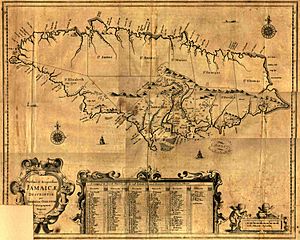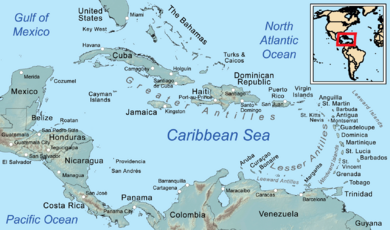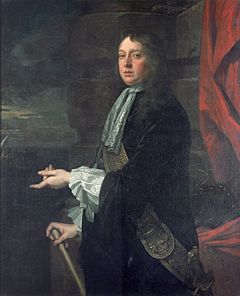Robert Venables facts for kids
Quick facts for kids
Robert Venables
|
|
|---|---|

Map of Jamaica, captured by Venables during the 1655 Western Design
|
|
| Born | 1613 Antrobus, Cheshire |
| Died | 10 December 1687 (aged 73–74) Wincham, Cheshire |
| Allegiance | |
| Years of service | 1642–1655 |
| Rank | General |
| Unit | Jones' Regiment of Horse |
| Commands held | Governor of Tarvin Western Design, 1654–1655 Governor of Chester, 1660 |
| Battles/wars | Wars of the Three Kingdoms Chester; Rowton Heath; Oxford; Cromwellian conquest of Ireland Rathmines Drogheda Lisnagarvey Scarrifholis Charlemont Anglo-Spanish War Santo Domingo Jamaica |
Robert Venables (around 1613–1687) was an English soldier from Cheshire. He fought for the Parliament in the Wars of the Three Kingdoms (1638-1651). He is best known for capturing Jamaica in 1655.
In 1654, when the Anglo-Spanish War began, Venables became a joint leader of a mission. This mission, called the Western Design, aimed to attack Spanish lands in the West Indies. Even though he captured Jamaica, which stayed a British colony for over 300 years, the mission was not seen as a success. This failure ended his military career.
After his military career, he became Governor of Chester in 1660. However, his religious beliefs did not fit with the new government of King Charles II. He then left public life. In 1662, he wrote a book about fishing called The Experienced Angler. This book was very popular and had five new editions during his lifetime. He lived quietly at his estate in Wincham, Cheshire, until he died in 1687.
Contents
Early Life and Family
Robert Venables was born around 1613. His father was also named Robert Venables (around 1579–1643). His mother was Ellen Simcox (1577–1658). The Venables family was a smaller branch of a very old family. They were considered part of the "minor gentry," which meant they were landowners but not nobles.
Robert's father was involved in the salt mining business in Cheshire. He was also part of a local group of Puritans. Robert's godfather was Richard Mather, a famous preacher.
Robert's first wife was Elizabeth Rudyard. They married in the mid-1630s, and she died before 1649. They had five children, but only two lived to be adults: Thomas (1640–1659) and Frances (1638–1692).
In 1649, before Venables went to Ireland, he got engaged to Elizabeth Lee (1614–1689). She was a widow with seven children. They married in 1654 when he returned. At the same time, Elizabeth's son Thomas married Robert's daughter Frances. Also, Robert's son Thomas married Elizabeth's daughter, also named Elizabeth. Their marriage was not very happy. Elizabeth reportedly "disliked his politics, disliked his religion, and did not approve of his manners."
Robert Venables: Soldier for Parliament
We don't know much about Robert Venables' early career. But in August 1642, when the First English Civil War began, he formed a company of soldiers for the Manchester army. In December, he was captured in a small fight but was quickly set free.
The Venables family had strong ties to the Breretons, a powerful family in Cheshire. Robert served under Sir William Brereton, a leading Parliamentarian in the area. Brereton was a strong leader, even without much military experience. He won battles at Middlewich and Hopton Heath in March 1643.
Brereton set up his main base at Nantwich. He soon gained control over Arthur Capell, the Royalist commander. From August to September 1643, Venables was based at Cholmondeley. From there, he attacked nearby Royalist bases. These attacks helped block Chester, a key town for the Royalists. Their success led to Capell being replaced by Lord Byron in October 1643.
Byron gathered an army of over 5,000 soldiers. Many were experienced fighters from the war in Ireland. In December, Byron defeated the Parliamentarians at the Second Battle of Middlewich. Brereton asked Sir Thomas Fairfax for help. Their combined forces defeated the Royalists at Nantwich in January 1644. Byron lost over 1,500 men and most of his cannons. He then retreated to Chester. Venables spent much of the next two years as governor of Tarvin. When Chester finally gave up in February 1646, Brereton suggested Venables as governor. But the job went to Michael Jones. Venables, now a lieutenant colonel, spent the next few months taking over Royalist bases in North Wales. The war ended in June.
Even with the victory, Parliament struggled to pay its soldiers. This was due to the high cost of the war, a bad harvest in 1646, and a new outbreak of the plague. In summer 1647, the soldiers at Nantwich rebelled. Venables restored order and became governor of Liverpool in January 1648. He held this position during the Second English Civil War.
In 1649, Venables was promoted to colonel. He raised a group of soldiers from Cheshire to help Michael Jones, who was the new Parliamentarian Governor of Dublin. They arrived in time for the Battle of Rathmines on August 2. This was a big victory over a Royalist and Confederate army.
On August 15, Oliver Cromwell arrived with 12,000 soldiers to start the conquest of Ireland. Venables helped in the storming of Drogheda. Venables, along with Sir Theophilus Jones, joined forces with Sir Charles Coote in Ulster. For the next year, they fought to control the north. This included battles like Lisnagarvey and Scariffhollis. Charlemont, the last Confederate stronghold in Ulster, surrendered in August 1650.
Venables spent the next two years fighting in north Connaught and south-west Ulster. His troops were often not paid on time. Sometimes, he and Jones had to take taxes meant for Dublin to pay their soldiers. In 1653, he helped put into practice the 1652 Act of Settlement, which was a harsh law for Ireland. He also resisted efforts to force Presbyterianism on people in Ulster. Like many in the New Model Army, he was a religious Independent. This meant he did not want the government to control the church.
The Western Design: A Caribbean Adventure

In May 1654, Venables left Ireland. He was made the commander of the land forces for the Western Design. This was a plan to attack Spanish lands in the Spanish West Indies. The goal was to get a permanent base in the Caribbean. Oliver Cromwell strongly supported this plan. He had been involved with the Providence Island Company, a Puritan colony that failed earlier.
The plan was based on advice from Thomas Gage, a former missionary. Gage claimed that the Spanish colonies of Hispaniola and Cuba were not well defended. This advice turned out to be wrong.
Venables knew the distances were huge. He wanted to be flexible with the mission's goals. Cromwell agreed. His orders were simply "to gain an interest in that part of the West Indies in possession of the Spaniards." Venables shared leadership with Admiral William Penn, who commanded the ships. Two other officials were also there to oversee the settling of any captured lands. The fleet left Portsmouth in December 1654. Venables' new wife, Elizabeth, went with him.
Few experienced soldiers wanted to go to an area known for diseases. Also, the mission's goals were unclear. So, many of the 2,500 soldiers from England were untrained and poorly equipped. They reached Barbados in late January. For the next two months, they recruited another 3,500 people. These were mostly indentured servants from Barbados and other islands. The Spanish already knew about the plan. This delay allowed them to send more soldiers to Hispaniola. The English plan relied on secrecy and having more soldiers, but neither was true.
The attack on Santo Domingo in April was a disaster. The soldiers recruited in Barbados were not well-trained. After losing nearly 1,000 men, mostly from disease or heatstroke, they left on April 30. Despite Admiral Penn's objections, Venables attacked Jamaica in late May. Jamaica was mainly a place for Spanish ships to resupply. The main settlement, Santiago de la Vega, was not well defended and quickly surrendered. However, Jamaican Maroons (groups of escaped slaves) continued to fight in the island's interior for several years.
By this time, the relationship between Venables and Penn had completely broken down. On June 25, Penn sailed for England. He wanted to tell his side of why the mission failed first. Venables followed him, arriving on September 9. He was very thin and sick. Cromwell accused both of them of leaving their posts and sent them to the Tower of London. They were soon released, but both were removed from their military positions. Penn later returned to the Royal Navy after King Charles II came back to power in 1660. But this was the end of Robert Venables' military career.
Life After the Military
Cromwell died in September 1658. His son, Richard, took over as Lord Protector. But the army removed Richard in May 1659. Venables supported bringing the king back, but he did not join Booth's Insurrection in August 1659. This rebellion was led by George Booth, a Presbyterian who had worked with Venables in Cheshire.
When George Monck took control of Parliament in February 1660, he made Venables governor of Chester. However, after King Charles II returned to power, Venables was removed from this job. Local Royalists pressured the new government to remove him. This ended his public career.
In 1662, he published his book, The Experienced Angler. It had a special introduction by Izaak Walton, another famous writer about fishing. The book was very popular and had five new editions during Venables' lifetime.
Venables was a strong supporter of local Nonconformists. These were Protestants who did not follow the official Church of England. He was accused of being involved in the Farnley Wood Plot in 1663, a plan against the king. But he was released without any charges. He also gave shelter to William Veitch, a Scottish Covenanter who was against the king, after the Pentland Rising in 1666. In 1683, he was accused of supporting the exiled Duke of Monmouth.
Venables also served as a trustee for Sir John Deane's College. This school was started in 1557 and had strong Puritan traditions. It was in Chester then, but moved to Northwich in 1905. Today, it is a Sixth form college.
In 1668, Robert Venables bought an estate at Wincham. He died there on December 10, 1687. He left his property to his daughter Frances.
Images for kids





